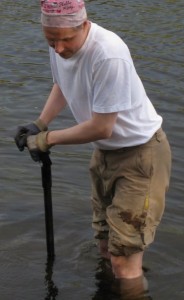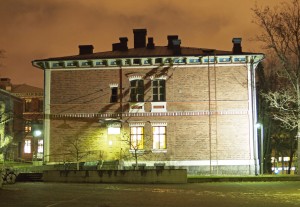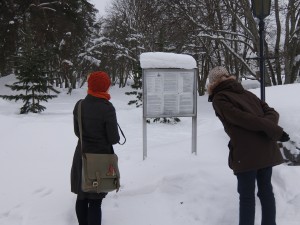Lapin synkkä kulttuuriperintö -hankkeen tiimi sai kutsun osallistua Lapin maakuntamuseon näyttelyn Wir waren Freunde – Olimme ystäviä virallisiin avajaisiin Arktikumissa. Näyttely keskittyy suomalaisten ja saksalaisten suhteisiin ennen Lapin sotaa vuodesta 1940 vuoteen 1944 kuten esittelyteksti kertoo:
”Vuoden 1940 syksyllä Lapin rautatieasemilla ja Jäämerentiellä alkoi näkyä vieraita kieliä puhuvia sotilaita. Lappilaiset ihmettelivät kotiseuduilleen yllättäen ilmestyneitä komeita univormuihin pukeutuneita saksalaisia sotilaita, jotka ottivat vähitellen käyttöönsä rakennukset ja kentät. Tästä alkoi suomalaisten ja saksalaisten neljä vuotta kestänyt yhteiselo, joka päättyi dramaattisesti Lapin tuhoutumiseen syksyllä 1944.”
Kartoittaaksemme nykypäivän ihmisten suhdetta sota-ajan kulttuuriperintöön toteutamme näyttelyyn liittyvän kävijäkyselyn, jonka tarkoituksena on, että näyttelyssä vierailevat voivat jakaa kanssamme näyttelyn herättämiä ajatuksia. Kyselylomake ja palautuslaatikko löytyvät Arktikumista näyttelyn sisäänkäynnin luota. Jos olet vieraillut näyttelyssä, mutta unohdit täyttää kyselyn, voimme lähettää kyselyn sähköpostitse. Tiedustelut: DarkHeritageLapland[at]gmail.com.

Mobile app bringing WW2 images in the exhibition to life. Photo by Eerika Koskinen-Koivisto.
The ‘Lapland’s Dark Heritage’ team were recently honoured to be invited to the official opening of the new exhibition at Arktikum – the Provincial Museum of Lapland – entitled “Wir waren Freunde / Olimme ystäviä / We were friends”.
This exhibition presents and discusses the interactions and encounters between German and Finnish people in Lapland from the Autumn of 1940 until the Lapland War in 1944. As the exhibition description says:
“In autumn 1940, one started to encounter soldiers speaking foreign languages in railway stations and on the Arctic Ocean Road. Lappish people were amazed by the handsome, uniformed German soldiers that suddenly appeared in their land, taking over the buildings and fields. Thereby, the four-year coexistence of Germans and Finns began and ended dramatically with the destruction of Lapland in the autumn of 1944.”
As part of our research into understanding how people respond to the cultural heritage legacy of this period, we are inviting visitors to the exhibition to share their thoughts and impressions with both us and the museum staff through a short questionnaire survey. Paper copies of the survey will be available at the exhibition itself and can be returned to the box next to the entrance of the exhibition.
If you have visited the exhibition and would like to fill in a survey, please email us (DarkHeritageLapland[at]gmail.com), and we can send you an electronic copy.





